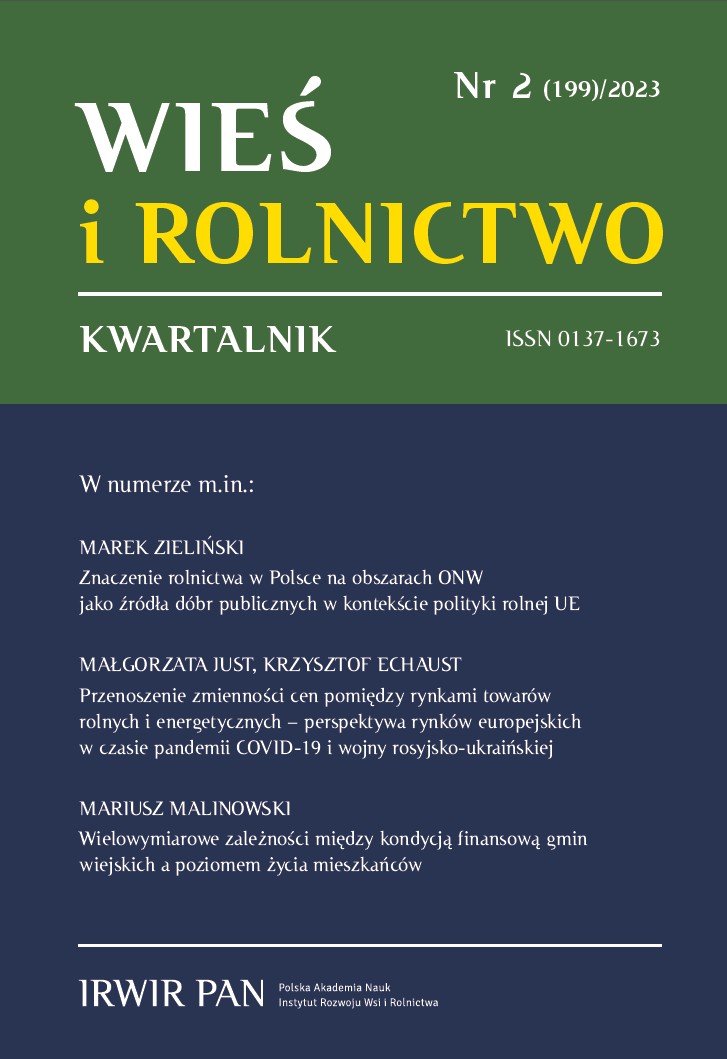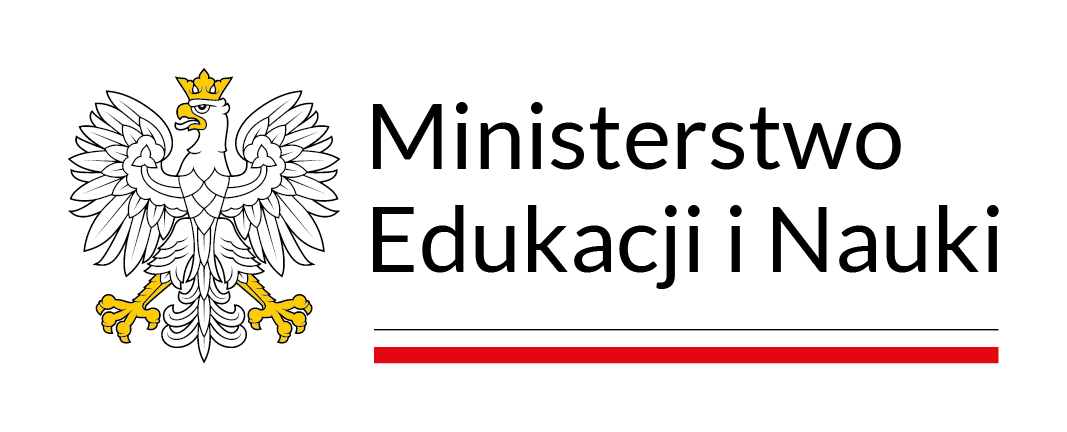Price Volatility Spillovers among Agricultural and Energy Commodity Markets: The Perspective of European Markets During the COVID-19 Pandemic and the Russia-Ukraine War
DOI:
https://doi.org/10.53098/wir022023/02Keywords:
price volatility, volatility spillovers, agricultural commodities, energy commoditiesAbstract
The study aims to assess the price volatility connectedness across agricultural and energy futures markets, and in particular, to identify the markets that are the main sources of price volatility among the markets considered. We analysed volatility spillovers among wheat, maize, rapeseed, Brent oil and natural gas on the Euronext and ICE exchange in the period from January 2017 to January 2023. We used the spillover index of Diebold and Yilmaz based on a generalised forecast error variance decomposition and its frequency extension of Barunik and Křehlík. The period from the outbreak of the COVID-19 pandemic to the beginning of 2023 brings an increase in price volatility in the food and energy markets. In the COVID-19 pandemic, the volatility spillover effect among markets was twice as strong as in 2017–2019, and three times stronger than during the Russia–Ukraine war. The main source of market shocks during the spread of the SARS-CoV-2 virus was the rapeseed market, while during the war in Ukraine this role was taken over by the wheat market. The volatility was not immediately transferred, thus providing an opportunity to implement risk management procedures to mitigate the impact of shocks from one market to another.
References
Abbott P.C., Hurt C., Tyner W.E. (2009). What’s Driving Food Prices? Farm Foundation Issue Report. Oak Brook, IL., 58–64. https://www1.eere.energy.gov/bioenergy/pdfs/farm_ foundation_whats_driving_food_prices.pdf (dostęp: 28.03.2023).
Ang A., Bekaert G. (2002). International asset allocation with regime shifts. Review of Financial Studies, 15 (4), 1137–1187. DOI: https://doi.org/10.1093/rfs/15.4.1137
Antonakakis N., Chatziantoniou I., Gabauer D. (2020). Refined measures of dynamic connectedness based on time-varying parameter vector autoregressions. Journal of Risk and Financial Management, 13 (4), 84. DOI: https://doi.org/10.3390/jrfm13040084
Baffes J. (2007). Oil spills on other commodities. Resources Policy, 32 (3), 126–134. DOI: https://doi.org/10.1016/j.resourpol.2007.08.004
Balcilar M., Bekun F.V. (2020). Do oil prices and exchange rates account for agricultural commodity market spillovers? Evidence from the Diebold and Yilmaz Index. Agrekon, 59 (3), 366–385. DOI: https://doi.org/10.1080/03031853.2019.1694046
Barbaglia L., Croux C., Wilms I. (2020). Volatility spillovers in commodity markets: A large t-vector autoregressive approach. Energy Economics, 85, 104555. DOI: https://doi.org/10.1016/j.eneco.2019.104555
Baruník J., Křehlík T. (2018). Measuring the frequency dynamics of financial connectedness and systemic risk. Journal of Financial Econometrics, 16 (2), 271–296. DOI: https://doi.org/10.1093/jjfinec/nby001
Bouri E., Demirer R., Gupta R., Pierdzioch C. (2020). Infectious diseases, market uncertainty and oil market volatility. Energies, 13 (16), 4090. DOI: https://doi.org/10.3390/en13164090
Chang C.-L., McAleer M., Wong W.-K. (2020). Risk and financial management of COVID-19 in business, economics and fi nance. Journal of Risk and Financial Management, 13 (5), 102. DOI: https://doi.org/10.3390/jrfm13050102
Chang T.-H., Su H.-M. (2010). The substitutive effect of biofuels on fossil fuels in the lower and higher crude oil price periods. Energy, 35 (7), 2807–2813. DOI: https://doi.org/10.1016/j.energy.2010.03.006
Czech K., Górska A., Kozioł-Kaczorek D. (2019). Związki cenowe towarów w warunkach finansjeryzacji gospodarki na przykładzie cen ropy naftowej, złota i pszenicy. Warszawa: Wydawnictwo SGGW.
Diebold F.X., Yilmaz K. (2015). Financial and Macroeconomic Connectedness: A Network Approach to Measurement and Monitoring. New York: Oxford University Press. DOI: https://doi.org/10.1093/acprof:oso/9780199338290.001.0001
Diebold F.X., Yilmaz K. (2012). Better to give than to receive: Predictive directional measurement of volatility spillovers. International Journal of Forecasting, 28 (1), 57–66. DOI: https://doi.org/10.1016/j.ijforecast.2011.02.006
Diebold F.X., Yilmaz K. (2009). Measuring financial asset return and volatility spillovers, with application to global equity markets. The Economic Journal, 119 (534), 158–171. DOI: https://doi.org/10.1111/j.1468-0297.2008.02208.x
Du X., Yu C.L., Hayes D.J. (2011). Speculation and volatility spillover in the crude oil and agricultural commodity markets: A Bayesian analysis. Energy Economics, 33, 497–503. DOI: https://doi.org/10.1016/j.eneco.2010.12.015
El Montasser G., Malek Belhoula M., Charfeddine L. (2023). Co-explosivity versus leading effects: Evidence from crude oil and agricultural commodities. Resources Policy, 81, 103331. DOI: https://doi.org/10.1016/j.resourpol.2023.103331
Euronext (2023). Commitments of Traders Report. https://live.euronext.com/products/commodities/commitments_of_traders (dostęp: 9.02.2023).
Farid S., Naeem M.A., Paltrinieri A., Nepal R. (2022). Impact of COVID-19 on the quantile con nectedness between energy, metals and agriculture commodities. Energy Economics, 109, 10596. DOI: https://doi.org/10.1016/j.eneco.2022.105962
Gong X., Liu Y., Wang X. (2021). Dynamic volatility spillovers across oil and natural gas futures markets based on a time-varying spillover method. International Review of Financial Analysis, 76, 101790. DOI: https://doi.org/10.1016/j.irfa.2021.101790
Hamulczuk M., Klimkowski C. (2011). Powiązania między cenami ropy a cenami pszenicy w Polsce. Roczniki Nauk Rolniczych, seria G, 98 (3), 176–190. DOI: https://doi.org/10.22630/RNR.2011.98.3.39
Hassen T.B., Bilali H.E. (2022). Impacts of the Russia-Ukraine war on global food security: Towards more sustainable and resilient food systems? Foods, 11 (15), 2301 DOI: https://doi.org/10.3390/foods11152301
Hung N.T. (2021). Oil prices and agricultural commodity markets: Evidence from pre and during CO VID-19 outbreak. Resources Policy, 73, 102236. DOI: https://doi.org/10.1016/j.resourpol.2021.102236
IGC [International Grains Council] (2022a). Grain Market Report: Russia-Ukraine conflict. https://www.igc.int/en/gmr_summary.aspx (dostęp: 27.01.2023).
IGC (2022b). Databank: Ukraine production and trade (main grains & oilseeds/products). https://www.igc.int/en/downloads/2022/gen2122misc1.pdf (dostęp: 27.01.2023).
Irwin S.H., Sanders D.R. (2012). Financialization and structural change in commodity futures markets. Journal of Agricultural and Applied Economics, 44 (3), 371–396. DOI: https://doi.org/10.1017/S1074070800000481
Ji Q., Bouri E., Roubaud D., Shahzad S.J.H. (2018). Risk spillover between energy and agricultural commodity markets: A dependence-switching CoVaR-copula model. Energy Economics, 75, 14–27. DOI: https://doi.org/10.1016/j.eneco.2018.08.015
Just M., Echaust K. (2022). Dynamic spillover transmission in agricultural commodity markets: What has changed after the COVID-19 threat? Economics Letters, 217, 110671. DOI: https://doi.org/10.1016/j.econlet.2022.110671
Just M., Echaust K. (2020). Stock market returns, volatility, correlation and liquidity during the COVID-19 crisis: Evidence from the Markov switching approach. Finance Research Letters, 37, 101775. DOI: https://doi.org/10.1016/j.frl.2020.101775
Kumar D. (2017). On volatility transmission from crude oil to agricultural commodities. Theoretical Economics Letters, 7, 87–101. DOI: https://doi.org/10.4236/tel.2017.72009
Le Z., Su Y. (2020). Dynamic spillovers between international crude oil market and China’s commodity sectors: Evidence from time-frequency perspective of stochastic volatility. Frontiers in Energy Research, 8. DOI: https://doi.org/10.3389/fenrg.2020.00045
Liu W. (2009). Analysis of co-integration and volatility spillover effects between Chinese and international agricultural products futures markets. 2009 International Conference on Management and Service Science, 10953556. https://ieeexplore.ieee.org/document/5301807 (dostęp: 31.01.2023) DOI: https://doi.org/10.1109/ICMSS.2009.5301807
Nyga-Łukaszewska H., Aruga K. (2020). Energy prices and COVID-immunity: The case of crude oil and natural gas prices in the US and Japan. Energies, 13 (23), 6300. DOI: https://doi.org/10.3390/en13236300
Pal D., Mitra S.K. (2020). Time-frequency dynamics of return spillover from crude oil to agricultural commodities. Applied Economics, 52 (49), 5426–5445. DOI: https://doi.org/10.1080/00036846.2020.1764482
Paris A. (2018). On the link between oil and agricultural commodity prices: Do biofuels matter? International Economics, 155, 48–60. DOI: https://doi.org/10.1016/j.inteco.2017.12.003
Parkinson M. (1980). The extreme value method for estimating the variance of the rate of return. Journal of Business, 53 (1), 61–6 5. DOI: https://doi.org/10.1086/296071
Pesaran H.H., Shin Y. (1998). Generalized impulse response analysis in linear multivariate models. Economics Letters, 58 (1), 17–29. DOI: https://doi.org/10.1016/S0165-1765(97)00214-0
Rokicki T., Perkowska A., Klepacki B., Bórawski P., Bełdycka-Bórawska A., Michalski K., (2021). Changes in energy consumption in agriculture in the EU countries. Energies, 14 (6), 1570. DOI: https://doi.org/10.3390/en14061570
Rosiak E. (red.) (2021). Rynek rzepaku. Stan i perspektywy. Analizy Rynkowe, 59.
Shah A.A., Dar A.B. (2022). Asymmetric, time and frequency-based spillover transmission in financial and commodity markets. Journal of Economic Asymmetries, 25, e00241. DOI: https://doi.org/10.1016/j.jeca.2022.e00241
Śmiech S., Papież M., Fijorek K., Dąbrowski M.A. (2019). What drives food price volatility? Evidence based on a generalized VAR approach applied to the food, financial and energy markets. Economics, 13 (1), 20190014. DOI: https://doi.org/10.5018/economics-ejournal.ja.2019-14
Taghizadeh-Hesary F., Rasouline zhad E., Yoshino N. (2019). Energy and food security: Linkages through price volatility. Energy Policy, 128, 796–806. DOI: https://doi.org/10.1016/j.enpol.2018.12.043
Tang K., Xiong W. (2012). Index investment and financialization of commodities. Financial Analysts Journal, 68 (6), 54–74. DOI: https://doi.org/10.2469/faj.v68.n6.5
Tibshirani R. (1996). Regression shrinkage and selection via the lasso. Journal of the Royal Statistical Society. Series B (Methodological), 58 (1), 267–288. DOI: https://doi.org/10.1111/j.2517-6161.1996.tb02080.x
Tiwari A.K., Abakah E.J.A., Adewuyi A.O., Lee C.-C. (2022). Quantile risk spillovers between energy and agricultural commodity markets: Evidence from pre and during COVID-19 outbreak. Energy Economics, 113, 106235. DOI: https://doi.org/10.1016/j.eneco.2022.106235
Tomaszewski J. (2015). Finansjalizacja a zmiany strukturalne na rynku towarów rolnych w pierwszych latach XXI w. Annales Universitatis Mariae Curie-Skłodowska. Sectio H. Oeconomia, 49 (4), 601–610. DOI: https://doi.org/10.17951/h.2015.49.4.601
Wei C.C., Ch en S.M. (2016). Examining the relationship of crude oil future price return and agricultural future price return in US. International Journal of Energy Economics and Policy, 6 (1), 58–64.
Wheeler C.M., Baffes J., Kabundi A.N., Kindberg-Hanlon G., Nagle P.S.O., Ohnsorge F.L. (2020). Adding fuel to the fire: Cheap oil during the COVID-19 pandemic. Policy Research Working Paper Series 9320, The World Bank. https://ideas.repec.org/p/wbk/wbrwps/ 9320.html (dostęp: 23.06.2021). DOI: https://doi.org/10.1596/1813-9450-9320
World Bank Group (2022). Commodity Markets Outlook: The Impact of the War in Ukraine on Commodity Markets, April 2022. A World Bank Report. Washington, DC: World Bank. https://openknowledge.worldbank.org/bitstream/handle/10986/37223/CMOApril-2022.pdf (dostęp: 27.01.2023).
Xiarchos I.M., Burnett J.W. (2018). Dynamic volatility spillovers between agricultural and energy commodities. Journal of Agricultural and Applied Economics, 50 (3), 291–318. DOI: https://doi.org/10.1017/aae.2017.34
Yang J., Li Z., Miao H. (2021). Volatility spillovers in commodity futures markets: A network approach. Journal of Futures Markets, 41 (12), 1959–1987. DOI: https://doi.org/10.1002/fut.22270
Yang J., Qiu H., Huang J., Rozelle S. (2008). Fighting global food price rises in the developing world: The response of China and its effect on domestic and world markets. Agricultural Economics, 39 (Suppl. 1), 453–464. DOI: https://doi.org/10.1111/j.1574-0862.2008.00351.x











